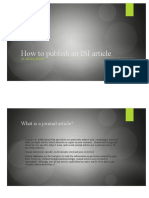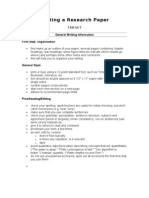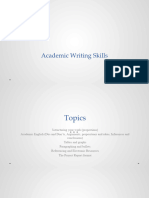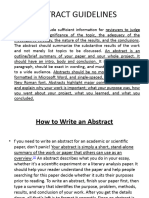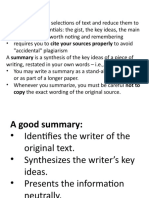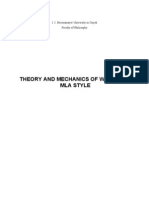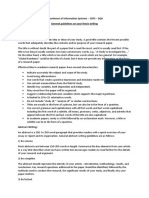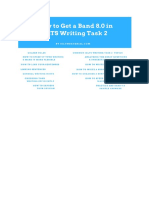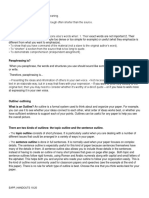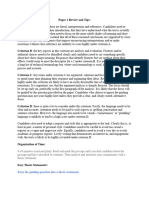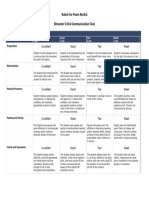SomeGuidlines For Thesis
SomeGuidlines For Thesis
Uploaded by
Hinn Linn PyinnCopyright:
Available Formats
SomeGuidlines For Thesis
SomeGuidlines For Thesis
Uploaded by
Hinn Linn PyinnOriginal Title
Copyright
Available Formats
Share this document
Did you find this document useful?
Is this content inappropriate?
Copyright:
Available Formats
SomeGuidlines For Thesis
SomeGuidlines For Thesis
Uploaded by
Hinn Linn PyinnCopyright:
Available Formats
Helsinki University of Technology Networking Laboratory
12.12.2005 version 1.0
SOME GUIDELINES FOR THESIS CONTENTS AND WRITING
For writing the contents of your thesis, numerous common rules apply, some of which are listed below. These are by no means complete but rather provide a first guidance to avoid many pitfalls. 1. Structure Each thesis has an introduction and a conclusion: o The introduction is meant to motivate the subject area (why is this important?), define the problem you are interested in (what are you doing?), and limit the scope (where do you stop?). It also gives an outline of the thesis (which chapters will explain what?) and explains how you are going the approach your subject. o The conclusion is meant as a review and not just as a summary. Critically assess your thesis and its results, discuss what you have learned, and point out what next steps would or could be and maybe give your perspective on future development (where meaningful and possible). o Find a good first and last sentence: no thesis should start unexpectedly and end abruptly. This usually takes more than five minutes. Each chapter has an introduction in which you briefly explain the purpose of the chapter and possibly its structure and relate it to the previous ones. o The introduction comes right after the chapter title without additional headline (such as Introduction) within a chapter. It is natural that this is the first thing; so there is no point in stating the obvious. Each chapter should have a conclusion, summary, or something similar that reviews the achievements of the respective and relates it to what follows. Again, no chapter should start or end abruptly. Describe the context and background of your thesis and discuss related work. Explain what you are building on and why (and what not and why not). Discuss your own contribution: its concepts and approach, its realization, and its assessment. Make sure that your own work gets enough room (also in terms of pages). For example, a 70 page thesis should not have 50 pages of introduction, background, and related work, and then only given 10 pages to your own work, followed by 10 pages conclusions and references. Make clear that your own contribution is clearly delineated from what has already been there. Balance chapters. Introduction and conclusion should be the shortest ones. The others may vary from 5 to 40 pages (depending on the total size of the thesis). Avoid a single dominating chapter (e.g., one with 40 pages if all others have 5 is an indication that something is wrong). Structure into chapters, sections, subsections, and paragraphs. Try to avoid more than 3 levels of numbered headlines unless really necessary (if you find it necessary this may tell you that your overall structure needs to be reworked). o You may use two levels of unnumbered headlines for further structuring (e.g., bold and italics), optionally peered with bullet or numbered lists. o These should not show up in the table of contents. Use bullet list or numbered lists to emphasize or list issues for readability but remember to use full sentences even across bullets. Bullet lists do not substitute full text explanations 2. Systematic approach and methods The research and/or engineering approach of a thesis roughly follows a general structure problem statement/definition method solution validation / analysisand, of course, includes consideration of related work at the appropriate location(s). Note that these may but need not map 1:1 to chapters in your thesis. The depth of these steps may vary depending on your precise subject and the field of research. The problem statement sets the frame for your thesis: what you define here as your problem to solve MUST be solved in the end (or you need a well-founded answer why it has not been). An outline of the problem definition is done (orally) together with your instructor and/or supervisor and you are likely to have prepared a summary of this in a expos when discussing with your supervisor before applying for the thesis. The problem definition part in the thesis reflects this content in a more formalized manner.
1/3
Helsinki University of Technology Networking Laboratory
12.12.2005 version 1.0
The method defines your approach to the subject. This part may differ significantly depending on your actual subject: In mathematics, the methods you employ may be straightforward and well-known and require only a few sentences to say what you are doing and why. In techno-economics (or economics and other soft sciences), the method is often significant part of the science (and your thesis) and your chosen approach (as well as the alternatives) may not be obvious so that it becomes crucial to extensively elaborate on your method. Engineering theses fall somewhere in-between. Your measure should beagainthat your thesis can be understood by others while reading. The solution describes what you have done and why, possibly what you have not done (and why not). This is the meat of your thesis, i.e. your own contribution to the field. Finally, the validation critically reviews what you have done and demonstrates that it achieves the intended goals (i.e., solves the problem). This also points out what could still be improved and could be subject to next steps in the future (there will always be something!).
3. Headlines The basic rule is: headlines are for structuring but the text (at least within a chapter) should be readable and understandable if you delete all the headlines. No headline should follow immediately on another. That is, there must always be text between them to motivate, introduce, etc. Each headline should fit on a single line (and this should also hold for the table of contents). Use meaningful headlines that describe the contents of the following section. Propose a meaningful title for your thesis (that can be understood also by those not involved). The title should not contain abbreviations beyond those that are well known by the general public. 4. Writing in general The usual rules for scientific writing (proper citations, references, etc.) apply. Define the key terms and concepts in your subject area. A definition is a sentence that has the term, the verb is and then the meaning of the term. Another verb such as means produces an explanation rather than a definition. Always define terms first and then use them. It is better to define the terms as you need them rather than in a separate section or chapter unless the terms form an abstract model. Separate thoughts by using different paragraphs (1 thought = 1 paragraph). Do not make paragraphs too long (maybe your thought has more structure). Write down what you mean (and make sure it says so). Avoid sentences without meaning (just because something sounds or reads nicely does not imply that it has a purpose). Never have an unnecessary paragraph in a chapter, or an unnecessary sentence in a paragraph, or an unnecessary word in a sentence. And, say everything essential. Write complete English sentences (do not forget the articles where needed). Preserve proper punctuation also in or across bullet lists. Write in a scientific and strict fashion. Do not use colloquial English or magazine-style of writing (unless there is a good reason to do so). For readability, avoid complex sentences. Try to phrase your thoughts as simple as possible. Write to the point (and do not fill pages just for the sake of filling them). 5. Proof-reading (for yourself or for others) Do not imply meaning. Only evaluate what is really written (the prof will do the same). Be most critical and ask yourself what the text really says (otherwise, there is no point in proof-reading in the first place). If in doubt about language ask a dictionary or a grammar book. Taking a step back and allowing a day or a week to pass before re-reading helps to spot issues. 6. If you use English language Take a conscious decision whether to use British or American English (and stick to it). Avoid first person singular (I); use we instead or write from a neutral standpoint. Do not use short forms in written language (dont => do not, cant => cannot, etc.). Avoid too much passive language. Write in present tense unless you really have to express temporal relationships. 2/3
Helsinki University of Technology Networking Laboratory
12.12.2005 version 1.0
An English grammar can be very helpful to find the right prepositions. Commas: If in doubt, leave it out. Relative clauses following the main clause are usually not separated by a comma unless specific semantics shall be expressed. Leading phrase such as In this thesis, or Today, or In networking, are separated by a comma from the rest of the sentence. A relative clause ahead of the main clause is separated from it by a comma. Differentiate knowingly between -, , , etc. Avoid abbreviations. Surely allowed are i.e., e.g. (that are followed by a comma), and etc. (which is preceded by a comma). Use proper spacing if supported by your text tool: the previous bullet shows i.e. without a space, but that should be half a space. After a full stop (period), there should be 1.5 spaces before the first word of the next sentence (using two spaces is usually better than one). The quality of the text must be comparable to native language. Besides the abstract in English, you must have the abstract also in Finnish. On the Finnish abstract, you must provide the Finnish title for the thesis.
7. Figure, Tables, Equations Particularly figures help making the text more readable and keep the reader from falling into despair (or, at least, asleep) because of 60 pages of pure text, text, and text. But dont write a comic. Use only meaningful figures or tables that really add value. Reference explicitly and explain every figure, table, and equation. E.g. one writes: Figure 1.2 shows . Note that all figures and tables are for illustration purposes. Finally, it is the text that matters, i.e. your text should carry all the thoughts that you wish to convey to the reader. Use a coherent numbering and labeling scheme for all of them. 8. Formatting Use a readable serif font (e.g., Time-New-Roman). Make reasonable use of the space on an A4 page and avoid too wide margins. Use 11 or 12 point font and at least 1.5 line spacing for copies to the thesis supervisor so that is possible to write between the lines with a pen. You may reformat to one line spacing for the final bound version (preferred). Use coloring, shading, or other forms of emphasis, typesetting rules, etc. consistently. Make sure that your thesis looks like a final product and not like an early prototype o Page breaks are in the proper locations (no orphans or widows). o Proper graphics embedded in a scalable format (no bitmaps except for photographs) so that the results do not look like from a dot matrix printer. o Graphics use sans-serif fonts. o Text margins aligned with tables and figures. o Start each chapter on a new page and leave some white space on the first page of the chapter. If you use colors in figures or graphs, remember that your thesis should also be readable and understandable when printed on a black and white printer. For the title page, follow the department guidelines. Do not forget to a serial number from the Lab before submission. Finally: form follows function: while a proper presentation is important the contents is even more.
3/3
You might also like
- Maynilad (Sample Bill)Document1 pageMaynilad (Sample Bill)Theo Amadeus50% (2)
- Marketing CasebookDocument34 pagesMarketing CasebookGandhi MardiNo ratings yet
- SOAP Bible Study Workbook 1 PDFDocument11 pagesSOAP Bible Study Workbook 1 PDFJuliannera Rodriguez78% (9)
- How To Write A Critical ReviewDocument4 pagesHow To Write A Critical Reviewdweiss99No ratings yet
- Structural Steel LessonsDocument7 pagesStructural Steel LessonsIngeniero EstructuralNo ratings yet
- Core Java Interview Questions and AnswersDocument5 pagesCore Java Interview Questions and AnswersatoztargetNo ratings yet
- Goldstein Classical Mechanics 3rd PDFDocument3 pagesGoldstein Classical Mechanics 3rd PDFJason0% (1)
- How To Write A Critical ReviewDocument4 pagesHow To Write A Critical Reviewjungaa1No ratings yet
- English For Writing Research Paper: Abstract and IntroductionDocument15 pagesEnglish For Writing Research Paper: Abstract and IntroductionMark Alvin OcampoNo ratings yet
- How To Summarize A Research Article PDFDocument3 pagesHow To Summarize A Research Article PDFSaieed M.NNo ratings yet
- Summarizing A Research ArticleDocument3 pagesSummarizing A Research ArticleRahib JaskaniNo ratings yet
- Academic Writing GuideDocument32 pagesAcademic Writing GuidekaavyaNo ratings yet
- Writing Good Scientific Papers (Tambien Sobre El Abstract)Document106 pagesWriting Good Scientific Papers (Tambien Sobre El Abstract)FisicoRFCNo ratings yet
- Writing An Academic EssayDocument4 pagesWriting An Academic EssayPathwayOfPeaceNo ratings yet
- Writing Summaries For ArticlesDocument16 pagesWriting Summaries For ArticlesFasih RehmanNo ratings yet
- Writing Thesis DR Avdesh Sharma SirDocument37 pagesWriting Thesis DR Avdesh Sharma SirRohit MathurNo ratings yet
- Writing SummaryDocument3 pagesWriting Summarymasruri123No ratings yet
- Writing Good Essays and AssignmentsDocument7 pagesWriting Good Essays and AssignmentsImran AhmedNo ratings yet
- How To Publish An ISI ArticleDocument24 pagesHow To Publish An ISI ArticleMuhammad Akmal100% (1)
- How To Write A Research PaperDocument8 pagesHow To Write A Research Paperesprules100% (1)
- Essay/Report Writing - Some Guidelines: AnalyseDocument5 pagesEssay/Report Writing - Some Guidelines: Analysemazzmazzmazz8No ratings yet
- Writing Research PapersDocument19 pagesWriting Research Papersluzvie_rementillaNo ratings yet
- Guidelines For Writing A Research Paper: Reading The TextDocument8 pagesGuidelines For Writing A Research Paper: Reading The Textm.afzaladamjee3646No ratings yet
- Essay Writing Process RmitDocument2 pagesEssay Writing Process Rmitapi-249904628No ratings yet
- Academic WritngDocument56 pagesAcademic Writngmaansoor hotel berbera100% (1)
- Guidelines For Writing Synopsis For PH.D Thesis: PurposeDocument8 pagesGuidelines For Writing Synopsis For PH.D Thesis: PurposeArunKumarNo ratings yet
- Writing TipsDocument7 pagesWriting TipsDorinNo ratings yet
- Session 7Document40 pagesSession 7brainstormbrightNo ratings yet
- How To Write A Research Paper PDFDocument6 pagesHow To Write A Research Paper PDFLaiba AshrafNo ratings yet
- What Is Technical ArticleDocument4 pagesWhat Is Technical ArticleAnonymous 04YbZImfNo ratings yet
- NOTES 3-The Five Paragraph EssayDocument29 pagesNOTES 3-The Five Paragraph EssayBakhita KiaraNo ratings yet
- How To Write An AbstractDocument6 pagesHow To Write An AbstractАня РатоваNo ratings yet
- Abstract Guidelines&MomDocument40 pagesAbstract Guidelines&MomMahendra KachchhavahNo ratings yet
- Writing in Philosophy - Josh MayDocument7 pagesWriting in Philosophy - Josh MaychetanmonNo ratings yet
- 8 Process of Stylistic AnalysisDocument8 pages8 Process of Stylistic AnalysisAwais TareqNo ratings yet
- LS 400 Putting The Research Paper Together PDFDocument11 pagesLS 400 Putting The Research Paper Together PDFAnabel PerezNo ratings yet
- Module 8.research - ReportDocument10 pagesModule 8.research - ReportUmiaziente SuchiNo ratings yet
- Cara Tulis Summary PDFDocument3 pagesCara Tulis Summary PDFamaniNo ratings yet
- Basics in SummarizingDocument27 pagesBasics in SummarizingSussy BakaNo ratings yet
- Tips To Write A Thesis 20141119Document4 pagesTips To Write A Thesis 20141119Puvanarajan RenganathanNo ratings yet
- Title Introduction and Literature ReviewDocument67 pagesTitle Introduction and Literature Reviewcatherincbk2No ratings yet
- unit3Document21 pagesunit3shinchanzzzz2000No ratings yet
- Mla Student Guidelines 2009Document70 pagesMla Student Guidelines 2009Tatjana BarthesNo ratings yet
- GuidelinesThesis GeneralDocument5 pagesGuidelinesThesis GeneralMayssa BougherraNo ratings yet
- How To Get 8.0 in Writing Task 2Document12 pagesHow To Get 8.0 in Writing Task 2Hendra Kurnia RakhmaNo ratings yet
- 2.basics Essay Thesis Abstract Outline StructuresDocument18 pages2.basics Essay Thesis Abstract Outline StructuresmugwovictorNo ratings yet
- Bahasa InggrisDocument20 pagesBahasa InggrisEuis NurjannahNo ratings yet
- English TaskDocument4 pagesEnglish Task5qs6xyvk6xNo ratings yet
- Marks Scheme and Essay IeltsDocument12 pagesMarks Scheme and Essay IeltsßläcklìsètèdTȜèNo ratings yet
- A Simple Approach To Report or Thesis WritingDocument6 pagesA Simple Approach To Report or Thesis WritingMohsin Islam RifatNo ratings yet
- Summary and Précis WritingDocument14 pagesSummary and Précis Writingkokoboy0369No ratings yet
- What Is A Lab ReportDocument4 pagesWhat Is A Lab ReportGanjuNo ratings yet
- Paraphrasing Outlining Direct Quoting Summarizing HandoutDocument4 pagesParaphrasing Outlining Direct Quoting Summarizing Handoutconz12No ratings yet
- UWC Handouts ReadingessaypromptsDocument3 pagesUWC Handouts ReadingessaypromptsdNo ratings yet
- Elements of A Research Proposal and ReportDocument21 pagesElements of A Research Proposal and Reportpinkagnes89% (19)
- Thesis / Dissertation ChecklistDocument3 pagesThesis / Dissertation ChecklistNikki LorraineNo ratings yet
- Paper GuidelinesDocument8 pagesPaper Guidelinesapi-141156084No ratings yet
- Karsten's Advice On Writing A Bachelor or Master ThesisDocument6 pagesKarsten's Advice On Writing A Bachelor or Master ThesisEnes TEMELNo ratings yet
- Paper 1 Review and TipsDocument4 pagesPaper 1 Review and TipsManar AlaaNo ratings yet
- Writing Tips: Thesis: Which SectionsDocument4 pagesWriting Tips: Thesis: Which SectionsAsanka RodrigoNo ratings yet
- EssaywritingDocument5 pagesEssaywritingapi-314279477No ratings yet
- Review and Revise DissertationDocument1 pageReview and Revise DissertationBahamut KujataNo ratings yet
- A+ Guide to Short Answer Essays: A+ Guides to Writing, #4From EverandA+ Guide to Short Answer Essays: A+ Guides to Writing, #4Rating: 5 out of 5 stars5/5 (1)
- IELTS Writing Task 2: a Step-by-Step Guide: Everything You Need to Know: Strategies, Tips and Traps, Ideas and VocabularyFrom EverandIELTS Writing Task 2: a Step-by-Step Guide: Everything You Need to Know: Strategies, Tips and Traps, Ideas and VocabularyNo ratings yet
- Nagaland TroutDocument4 pagesNagaland TroutSharmistha PaulNo ratings yet
- Bentham's Principle of UtilityDocument3 pagesBentham's Principle of UtilityAgrata MehrotraNo ratings yet
- Brand AQAGloss-Brochure - Product Overview Polymer Dispersions Architectural Coatings-EnglishDocument6 pagesBrand AQAGloss-Brochure - Product Overview Polymer Dispersions Architectural Coatings-EnglishPaul ChendeNo ratings yet
- Week 5 Business LoansDocument34 pagesWeek 5 Business Loans23-08439No ratings yet
- Washing Machine: en Instruction Manual and Installation InstructionsDocument68 pagesWashing Machine: en Instruction Manual and Installation InstructionsxistenseNo ratings yet
- EarthWear Annual Report 2021Document16 pagesEarthWear Annual Report 2021renad.dajemNo ratings yet
- Daftar Akun PT ManunggalDocument4 pagesDaftar Akun PT ManunggalPetty Silvi Nova MaharlikaNo ratings yet
- Dashboard Requirement ListDocument3 pagesDashboard Requirement ListRajnish KumarNo ratings yet
- 767 Thesis-0812 PDFDocument196 pages767 Thesis-0812 PDFRahimshaikhNo ratings yet
- BaydprDocument26 pagesBaydprSasi LokeshNo ratings yet
- CH 15 SMDocument44 pagesCH 15 SMwaqtawanNo ratings yet
- Foreclosure Session 1 ARFDocument18 pagesForeclosure Session 1 ARFSarah MeijiNo ratings yet
- I Am Roberto Clemente By:Jim GigliottiDocument2 pagesI Am Roberto Clemente By:Jim GigliottiAddyNo ratings yet
- A COMPARATIVE STUDY OF CONSUMER PREFERENCES Research by Shiven WadhwaDocument13 pagesA COMPARATIVE STUDY OF CONSUMER PREFERENCES Research by Shiven WadhwasamuwadhwaNo ratings yet
- Human RightsDocument11 pagesHuman RightsCyberR.DomingoNo ratings yet
- Vandalur ZooDocument1 pageVandalur ZooKavi Mukilan100% (1)
- Chemical Reaction Engineering: Subject Code:Ch.E-325Document103 pagesChemical Reaction Engineering: Subject Code:Ch.E-325muhammad shahadat awanNo ratings yet
- WAVEX Abstract Book FinalDocument35 pagesWAVEX Abstract Book FinalAlessandro PinNo ratings yet
- Computers & Education: Charles Calderwood, Phillip L. Ackerman, Erin Marie ConklinDocument11 pagesComputers & Education: Charles Calderwood, Phillip L. Ackerman, Erin Marie ConklinLeonardo MonteiroNo ratings yet
- Robinson, Wright, 2013Document10 pagesRobinson, Wright, 2013apanek930No ratings yet
- 2867 FullDocument5 pages2867 FullAhmad FauzanNo ratings yet
- Green SAE 2006 Formated5Document18 pagesGreen SAE 2006 Formated5Aishwarya DidoreNo ratings yet
- Rubric For Poem Recital PDFDocument1 pageRubric For Poem Recital PDFNhel JulioNo ratings yet
- ArticleDocument14 pagesArticleBEALU GIRMAYENo ratings yet



















